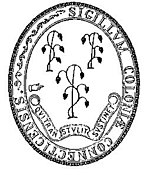Qui Transtulit Sustinet
| Great Seal of the State of Connecticut | |
|---|---|
 |
|
| Versions | |

Seal of the Colony of Connecticut (1711-1784)
|
|

Seal of the Colony of Connecticut (1639-1687)
|
|
| Details | |
| Armiger | State of Connecticut |
| Adopted | 1784 |
| Motto | Qui transtulit sustinet |
The Great Seal of the State of Connecticut has been the coat of arms of the U.S. state of Connecticut since May 1784. It depicts three grapevines and a ribbon below with the Latin motto: Qui Transtulit Sustinet (English: He who transplanted sustains), with SIGILLUM REIPUBLICÆ CONNECTICUTENSIS (English: Seal of the Republic of Connecticut) in the border.
The first seal of Connecticut was brought from England by Colonel George Fenwick in 1639. It was the seal of the Saybrook Colony and was turned over to the Connecticut Colony at about the time that it purchased the land and fort at Saybrook Point from Colonel Fenwick in 1644. The seal was used by the General Court (General Assembly) from that time forward, but there is no clear record of who had custody of the seal. On October 9, 1662 the assembly formally declared that the seal would be kept by the Secretary of the Colony and used as the Seal of the Colony on necessary occasions. It remained the colony's seal until October 1687, when Sir Edmund Andros took control of the colony's government and the seal disappeared.
On October 25, 1711 a meeting of the Governor and Council (upper house of the assembly) resolved, that "a new stamp shall be made and cut of the seal of this Colony, suitable for sealing upon wafers, and that a press be provided with the necessary appurtenances, for that purpose, as soon as may be, at the cost and charge of this Colony, to be kept in the secretary's office". The new, less elaborately decorated seal was larger in size and more oval shaped than the original. The words of the motto remained the same, but the number of grape vines was reduced to three and the legend Sigillum Coloniae Connecticutensis ("Seal of the Connecticut Colony") is added to the edge of the seal. The three vines may have been intended to represent the three colonies: New Haven Colony, Saybrook Colony and Connecticut Colony.
...
Wikipedia
